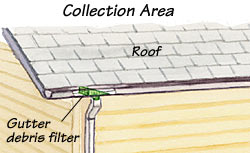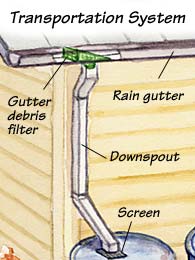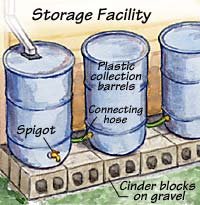 There’s money falling from the skies every time it rains. Here’s how you can harvest your share.
Creating a rainwater collecting and storage system is simple. (We’ll show you where to buy barrels and how to build your own.) And every time you use it to replace expensive, chemically treated city water in your garden, you’re saving money.
Best of all, this collection system is right over your head. The three elements of any rainwater harvester are the collection area, the transportation system and the storage facility.
Click the three areas on the illustration to the right see how to use these three elements to your garden’s advantage.
There’s money falling from the skies every time it rains. Here’s how you can harvest your share.
Creating a rainwater collecting and storage system is simple. (We’ll show you where to buy barrels and how to build your own.) And every time you use it to replace expensive, chemically treated city water in your garden, you’re saving money.
Best of all, this collection system is right over your head. The three elements of any rainwater harvester are the collection area, the transportation system and the storage facility.
Click the three areas on the illustration to the right see how to use these three elements to your garden’s advantage.
Collection area
 Anywhere falling rain doesn’t soak in to the ground, the runoff can be collected. So if you have a roof, you have a collection area.
Determining how much water your roof collects can involve lots of complex calculations. But all you really need to do is figure how much water your garden will need and if your roof can collect that much. The gardener who’s going to irrigate a large vegetable patch in the desert Southwest will need a lot more water than the one dousing a few container plants on a patio in the Midwest.
The rule of thumb is the average 25 foot by 40 foot home roof sheds about 600 gallons of water in an hour of moderate rainfall, around 1 inch. If you have two downspouts, they’ll each divert about 300 gallons of water toward the barrel under them. The more barrels you have, the more of this water you can collect.
Anywhere falling rain doesn’t soak in to the ground, the runoff can be collected. So if you have a roof, you have a collection area.
Determining how much water your roof collects can involve lots of complex calculations. But all you really need to do is figure how much water your garden will need and if your roof can collect that much. The gardener who’s going to irrigate a large vegetable patch in the desert Southwest will need a lot more water than the one dousing a few container plants on a patio in the Midwest.
The rule of thumb is the average 25 foot by 40 foot home roof sheds about 600 gallons of water in an hour of moderate rainfall, around 1 inch. If you have two downspouts, they’ll each divert about 300 gallons of water toward the barrel under them. The more barrels you have, the more of this water you can collect.
Transportation system

The gutters and downspouts along the edges of your roof are the water transportation system of your rainwater harvester.
Material — Gutters and downspouts can be made from aluminum or plastic. It’s the size, not the material that’s important.
Size — Gutters and downspouts have to be large enough to carry the water running off the roof. Most home gutters come 5 or 6 inches wide. 3-inch-diameter downspouts attach to the 5-inch gutters; 4-inch downspouts go on 6-inch gutters.
Forroof collection areas up to 1000 square feet, a 5-inch gutter and 3-inch downspout are large enough to carry the water. Larger roofs’ collection areas should have the larger size gutters and downspouts.
Filters — Be sure there are some kind of screens, such as the one in the illustration, to keep leaves and other debris from clogging the downspouts. In areas where mosquitos are a problem, use a fine-mesh, aluminum window screen to keep the insects away from the standing water in the barrel.
Storage Facility

Now we come to the heart of he rainwater harvesting system: Storing the rainwater you collect for use in dry times.
Barrels — There are several great water storage barrels available from specialty garden online catalogs, or you can build your own using Garden Gate‘s plan for constructing a rain barrel.
Placement — Whether you make barrels or buy them, they need to be placed properly.
Locate barrels under a downspout that’s also close to the thirstiest parts of your garden.
Dig out a 4-inch-deep area the length and width of the cinder block base. Fill the area with 1/4-inch pea gravel. This makes a base to help you level the cinder blocks and drain away water to keep your foundation dry.
The higher you can raise the barrels, the better the water pressure will be. Raising the barrels up also gets the spigot higher off the ground so you can get a watering can under it.
Capacity — Of course, you can only store the total gallons of water your rain barrels hold times the number of them you have.
Still, the system in the illustration, using three, standard 55-gallon drums, has 165 gallons of water ready and waiting to give the garden a drink when other supplies might not be available.
The more water you can store, the better. Short lengths of hose can be attached to individual barrels to link them together and boost the capacity of your system. And they can be added over time as you see how much water your garden needs.
Overflow — During heavy rains, there may be some overflow from the barrels. The 4-inch layer of gravel under the cinder blocks, as in the illustration, will divert this water away from your foundation. Or you can install an overflow port near the top of the barrel and attach a hose to divert excess water out to the garden.
Make a Rain Barrel
If you have gutters and downspouts on your house or garage, you have a fantastic system for harvesting soft, clear rainwater for the garden. The only missing piece is a collection reservoir, otherwise known as a rain barrel. To find one, check with companies that buy food ingredients in bulk. Some of their supplies come in large, seamless, plastic containers.Materials:
- 1 clean 30- to 55-gallon barrel or garbage can
- 1 “S”-shaped aluminum downspout elbow
- 4 concrete blocks
- 1 piece of aluminum window screen
- 1 standard 1-inch hose spigot with ¾-in. pipe threads
- 1 ¾-in. x ¾-in. coupling
- 1 ¾-in. x ¾-in. bushing
- 1 ¾-in. pipe thread with a 1-in. hose adapter
- 1 ¾-in. lock nut
- 4 metal washers
- 1 roll Teflon thread tape
- 1 tube silicon caulk
Tools:
- hacksaw
- screwdriver
- pop rivet gun with rivets
- drill
- pencil
- ruler
- spade
- level
- adjustable open end wrench
Scrub the inside of your container thoroughly with soap and water to remove any residues. Because they’re so hard to clean out, barrels that contained motor oil or fuel products don’t make good rain barrels. If you can’t find these barrels, you can substitute a large, plastic trash can.
Level the area for your barrel with a spade, set the concrete blocks in place and level them. To measure where the downspout elbow will come out from the side of the house and direct water into the barrel, put the barrel on the blocks. Hold the new elbow just above the top of the barrel and mark where the elbow will join the downspout — about an inch or so above the barrel is best.
Set the barrel and elbow aside and measure down 2 inches from the mark in the downspout. This will allow the downspout to fit into the elbow with a good, solid connection. Use the hacksaw to cut the downspout, then fit the elbow on and fasten it with sheet metal screws or pop rivets.
Drill a 3/4-inch hole in the wall of the barrel. Make it high enough to put a bucket underneath. Squeeze caulk around the hole on both sides. Next, refer to the illustration at right to build the spigot assembly. Connect the spigot and coupling, and wrap Teflon tape on each of the threaded ends for a tight seal. Slip on a washer and insert the threaded end of the coupling through the hole from the outside. On the inside, put a washer over the pipe and fasten everything together with the bushing.
A couple of inches down from the top of the barrel, drill another 3/4-inch hole. Then build the overflow assembly according to the illustration at right. Squeeze caulk around the hole inside and out and place a washer on the hose adapter. Push this assembly through the hole. Slip a washer and Teflon tape on the inside threads and tighten everything together with a nut. When you connect a length of garden hose to this overflow valve, you can direct some of the overflow into the garden after a heavy rain.
If your barrel has a lid, cut a hole where the new downspout elbow will direct water into it. Cover the hole with a piece of screen to keep mosquitoes out.
Finally, set the barrel back on the concrete blocks, make sure the downspout will direct water into it properly, and wait for the rain.
Rain Harvesting Sources
Commercial rain barrel and collection systems:
http://www.avlis.com/wedge/main.htm
http://www.whateverworks.com/gutter_wedge.htm
















